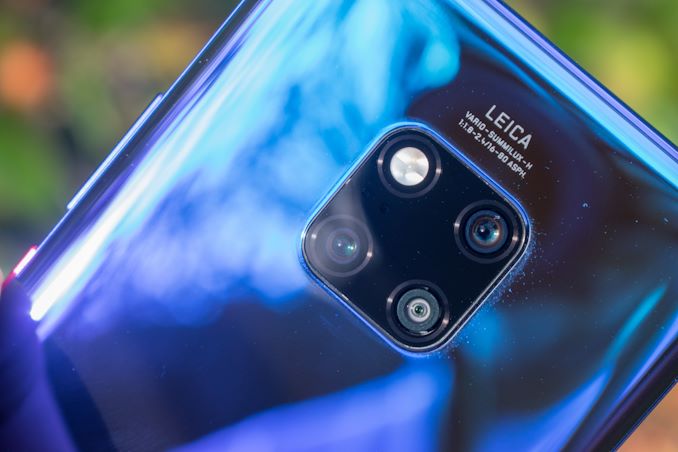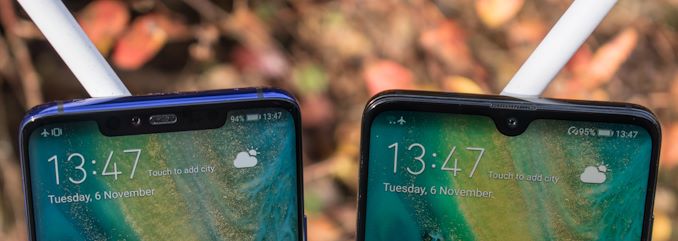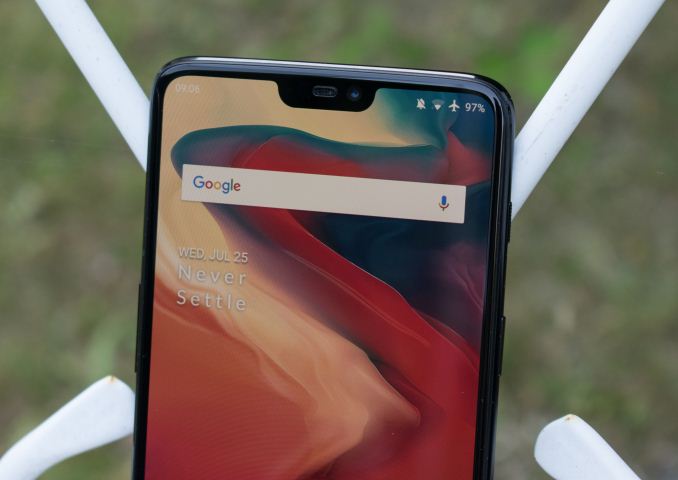AnandTech Year In Review 2018: Flagship Mobile
by Andrei Frumusanu on December 28, 2018 12:00 PM EST- Posted in
- Smartphones
- Apple
- Samsung
- LG
- Huawei
- Mobile
- SoCs
- OnePlus
- Year In Review

As we’re drawing to a close of the calendar year, it is time to look back and revisit what 2018 has brought to the mobile space. Unlike the PC industry, the mobile space follows a quite unrelenting and precise release schedule – meaning that we’re guaranteed new products every year: This can be a double-edged sword for new flagship mobile devices, as new technologies can be either ready at the leading edge of a new product cycle – or in the worst case they can miss the current generation altogether by a few months and have to be relegated to the next generation. Overall, smartphone companies have an incredibly complex task at hand in attempting to deliver products that not only represent an improvement to last year’s devices, but also to be able to distinguish themselves from the current competition. In this piece, we’ll have a closer look at the distinguishing trends of 2018 and how major players have executed their strategies this cycle.
How 2018 Will Be Remembered: Major Smartphone Camera Leaps
If I were to be asked what 2018’s flagship smartphones most defining characteristic would be, then I’d say their cameras. Essentially every vendor in 2018 has made significant leaps in terms of their camera performance, improving quality and adding new features. This year more than ever, we saw a significant amount of products make the camera their key selling point.
Starting off early in the year, Samsung lead the way with the release of the Galaxy S9. The S9’s camera on paper wasn’t too unusual, apart from the fact that the main camera module employed a new innovative dual-aperture mechanism. Samsung’s gains here were defined by sheer improvements of the camera hardware: The new sensor along with the new lens mechanism had raised the bar in terms of overall detail and sharpness, an aspect of the camera in which Samsung still maintains top marks up till today.
Another player whose camera improvements can be attributed to significant hardware leaps is Apple. The new iPhone XS and XR’s new camera module saw a major improvements in the sensor, with new larger pixels as well as a notably improved DTI implementation. The combination of great hardware and robust and consistent software processing made the new iPhone XS one of the best cameras of 2018.
The Year Where Camera Software Outshone Camera Hardware
Although Samsung’s and Apple’s camera improvements were significant – it was more or less an expected result of the newer generation hardware. While the hardware advances this year were solid, nothing left a quite an as quite as lasting impression as Huawei’s new computational photography on the P20 Pro and Mate 20 Pro.
[ Mate 20Pro ] - [ P20Pro ] - [ Pixel 3 ]
[ iPhone XS ] - [ S9+ ] - [ LG G7 ] - [ OnePlus 6 ]
Night mode on Huawei devices was something that was part of the company’s camera experience for a couple of years now – but it required use of a tripod to be able to get good results. The introduction of a new revamped hand-held Night Mode on the P20 Pro sparked a new era of true computational photography, achieving new levels of low-light performance that in the past would have been hard to imagine on a smartphone.
It’s only been recently, and almost half a year later that other companies followed suit: Most notable was Google’s “Night Sight” mode that was announced along the Pixel 3, with the feature also coming to the Pixel 2 and original Pixel. Here Google was able to one-up Huawei in terms of the low-light processing prowess.
I do think Huawei deserves a lot of credit for being a pioneer in terms of its use of computational photography: We’ve seen already many companies such as OnePlus and Xiaomi release new models and new camera software updates which bring night mode implementations of their own. I really do expect this feature to be a key checkmark item for smartphone vendors in 2019, with essentially all other major vendors following suit with new custom implementations.
The More Cameras the Merrier?
Another big trend by which 2018 smartphones will be remembered by, is the increasing amount of cameras on a smartphone. This year in particular has been pretty much the year in which having a telephoto module on your smartphone has become a mainstream feature. There’s still exceptions to this, particularly the smaller S9 from Samsung, along with Google’s Pixel phones. Vendors who don’t have a telephoto module per se, do still offer some added functionality with a second sensor; LG continued with its use of a wide-angle lens in the G7, while vendors such as OnePlus advertise the second sensor as being used for depth information.
In the last months of 2018 we saw the increase in camera modules go quite in the extreme: Instead of having to choose between either a telephoto or a wide-angle module, vendors such as Huawei, LG and Samsung have now started offering the trifecta of rear-camera configurations. Huawei’s introduction of a wide-angle module in the new Mate 20 and Mate 20 Pro make for a great addition to the capture experience, and we now finally see an alternative to LG in terms of seeing another major device offering the feature. Conversely, we also saw LG going the three-camera route in the new V40, adding for the first time a telephoto module in its new flagship. Much like the “night mode”, I expect the camera trifecta to be a key checkmark feature for flagship devices in 2019.
How 2018 Will Also Be Remembered: The Display Notch and its Repercussions
Apple’s 2017 iPhone X was the phone that pretty much “popularised” the display notch. While Apple wasn’t exactly the first company to introduce this, it paved the way for other companies to introduce designs that, wouldn’t it have been for the iPhone X, maybe wouldn’t have come to market with the designs that they did end up with.
Now I personally never really felt all that strongly about display notches for most of 2018: It was just something that I acknowledged to be there, but otherwise wasn’t neither a big positive nor negative for the phones. Huawei’s, LG’s and OnePlus’s first implementations this summer all worked quite seamlessly, and all of them allowed for “blacking out” the notch ears if one so wished.
Among Android devices, I think the only questionable implementations of the notch were on the Pixel 3 XL and on the Mate 20 Pro. The former just had an absurdly tall double-height notch that aesthetically just really wasn’t pleasant, all while having much inferior software options in terms of customising the “ears”. The Mate 20 Pro’s notch is the one that was most similar to the iPhone X; both in terms of functionality as well as design. Here I think the wider design actually hindered things on the software side, as I felt there wasn’t enough space left for the notification bar elements.
Now there’s arguably a lot of discussion if the display notch is worth it, but one thing that every company seems to agree on is that this is just an interim solution while everybody is working towards the goal of bezel-less devices. In fact, some companies this year have resorted to some quite radical designs; The Oppo Find X has a motorised camera housing sliding out of the top of the phone, hiding both front-facing and rear-facing cameras beneath the front screen and back glass. Another implementation is adopted by Honor, Xiaomi and Lenovo, devices such as the Honor Magic 2, Mi MIX3 and the new Z5 Pro, where the whole front-screen is mounted on a sliding mechanism, while the main body houses the internals as well as the camera hardware.
These solutions are quite innovative, however I do think they’re impractical and sacrifice a lot (Increased weight, lesser or no IP rating, and available thickness available to the camera modules) just for the goal of having a bezel-less display.
In general I feel less certain about where 2019 will lead us in terms of solving the display bezel/notch issue. Obviously there’s all eyes on Samsung as being one of the only hold-outs for most of 2018 who have resisted in adopting any model with a notch – here the company was quite public about its plans to adopt “Infinity-V” and “Infinity-O”, the former which is a usual V-shaped notch, while the latter will be using hole-in-active-display design.














65 Comments
View All Comments
Andrei Frumusanu - Friday, December 28, 2018 - link
> "Much better experience to your ears" is about as subjective a line as one could drop. Perception is different from ear to ear and person to person.You don't understand what subjective is.
Because perception thresholds are different for different persons, that is precisely exactly why a mechanism such as AS will be able to produce the single best result out of any audio product, and will be able that will be able to reproduce as near to an intended flat FR as possible.
The AS calibration procedure is a series of binary tests on whether you can hear a low amplitude frequency or not, this is not a subjective evaluation but an empirical determination with a consice answer of yes or no. It doesn't ask you if something sounds good or not, nor does it give you any control over the result, instead it spits a correctly compensated curve based on your hearing.
Shekels - Sunday, December 30, 2018 - link
The problem with AS is that it's on the S9. It can't power high fidelity headphones so what's the use of it producing a flat sound to your ears if the low grade earphones can't even produce close to accurate sound...SkyBill40 - Friday, December 28, 2018 - link
As a side note (and since I can't edit my comments), I understand that this is, in effect, an opinion piece. Given that, perhaps I should have approached my commentary slightly different. My intention was not to argue with you based on the premise of my opinion being better than yours because it's different, but instead to elicit productive conversation on the topic that isn't presented in quite as matter-of-fact as it has been thus far seeing that other testing reviews stand largely contrary to what you've stated here.Thanks for the discussion all the same, Andrei.
Andrei Frumusanu - Friday, December 28, 2018 - link
My "opinions" here on the topic are based on extensive testing with audio measurement equipment (electrical in terms of analog output, as well physical in terms of SPL out of units) on all the discussed devices. Just because I haven't written it down in a dedicated piece doesn't make it less "matter-of-fact" than anything else you might have seen.Krampus1999 - Saturday, December 29, 2018 - link
Skybill is correct, it's an opinion piece and opinions are subjective. When researching LG is well known for having some of the best sound quality, just as the Pixels are known for having the best camera's but you let your bias show in both counts.Shekels - Sunday, December 30, 2018 - link
https://www.audiosciencereview.com/forum/index.php...I urge you to read this. The LG G7 quad dac offers objectively superior sound quality than the Galaxy S8, and the S9 by a long shot. Saying otherwise as fact is simply wrong. The only reason to use the Quad Dac is with HiFi headphones like Sennheiser HD6XX (bottom line HiFi, 200USD so pretty much anyone can get them) so saying that's the only case where the G7 is better is just ridiculous. That's what it was meant for. Not to power your crappy 50$ earbuds. The S9 couldn't even power the HD6XXs. I've tried that combo and there is 0 bass, highs are screechy and the mids seem like they're 100 yards away. My Xiaomi Mi Mix 2 with it's dongle produces vastly superior audio quality to the S9 with high impedance headphones let alone the G7. Also Adaptive Sound barely changes anything (I can pretty much hear all the frequencies so it doesn't change much) and I noticed it introduced a bit of distortion and things just didn't sound as well when I used it. How the phones sound TO YOU are purely subjective. The output quality is obiective, and the G7 stomps the S9. Saying otherwise would be like saying a Civic can lap the nordschleife faster than a Porsche 911 GT2. You might like to drive the Civic more and feel like it drives nicer, but it sure as hell gets it's a$$ wooped in a race against the 911 GT2
aswool - Saturday, December 29, 2018 - link
Saying the Aqstic DAC in the Snapdragon devices is better than the Cirrus Logic is flat out wrong.However, I'm curious what lead you to that conclusion.
Objectively speaking, the DAC is the only redeeming part of the Exynos S9 this year.
Andrei Frumusanu - Saturday, December 29, 2018 - link
I measured the Snapdragon S9's to have better output power and lower THD than the Exynos S9's. In fact the Exynos has pretty much worse output than a vast majority of devices this year.Qualcomm has made great strides in the ASoCs the last couple of years.
Quantumz0d - Sunday, December 30, 2018 - link
Sorry I don't see how you see the distortion on the LG Audio with the ESS9218P DAC chip is a HiFi SoC which is only of its kind basically a patented hardware with multiple channels of Audio processing functionality of a Delta Sigma DAC from my knowledge with superb clarity, I might not know much of its hardware functionality, like you might have known. And there's a huge misconception among people that you need to trick it to high impedance mode and all for the QuadDAC to work which is wrong, Also how LG did the job on maintaining only lowest level DAC channels with a normal gear and go up with 3 modes (I think the primary reason is battery consumption by the ESS SoC due to it's supreme powerful nature as all in one)This is an AA piece on the LG V20 DAC which is good to learn stuff.
https://www.androidauthority.com/lg-v20-quad-dac-e...
But here are my impressions of it, vs my iPod 5.5G / iPod 6G / SGS i9000 with Voodoo mod all with one IEM Dunu DN 1000 (I have tried VSonic GR07 BE they were great but have Bass lacking severely and IE80s which have bad Audio due to Veil, the Triple Driver is very good in DN1Ks, Joker's theheadphonelist review is really great, checkout his site, his reviews are very very good and would apply to many)
https://theheadphonelist.com/headphone_review/dunu...
iPod 5.5G is very famous for the Wolfson DACs house sound due to it's lush 3Desque sound and the 6G moves away with a more "accurate" sonic performance making it fatiguing due to the metallic effect it has its powered by Cirrus Logic due to tightening of the Bass vs the 5.5Gs Audio performance.
The i9000 is one of the rare phones which has a full fledged Audio performance on a custom ROM, huge thanks to Supercurio, famous Android Developer for the Audio mod on it thanks to Wolfson drivers for the DAC chips. This paved way for the SGS III to have some similar functionality. The i9000 has all the settings from Dynamic Range to the Bass customization from the Mid / Sub Bass levels and the Analog DAC bypass processing for everything on phone. However the i9000 DAC performance falls short vs the iPod 5.5G due to the latter having more spacious soundstage allowing for more airy performance but it's not bad in any means it can be classified as warm signature, the clarity is superb on the iPods as a reason and very much engaging sound. Both are running 200GB SD cards. Even iPod as well, thanks to aftermarket modding community that device has more shelf life than any technology product I've came across with again a parametric EQ from Rockbox, OSS Linux OS. Mind you this is before Cirrus Logic bought them out sadly.
I was eyeing for a device which has good specs and feels great in hand that devices is none other than LG V30. It's very solid piece has exact dimensions as an OP3 yet has more in everything, the width is nor narrow and stupid like Samsung or iPhones and the camera doesn't have any bumps has this wide angle and USB to HDMI and lot.
The HiFi quad DAC, the end game. Read a lot and was skeptical, I've experimented various Digital Filters which I think is a good option but the presets are bad IMHO, The sound is simply magical, same IEMs, Dunu DN 1000, The Visceral deep bass is just pleasing and solid clarity the issue was sibilance due to TWFK drivers and more low end emphasis, mind you the clarity is still great it stomps over RHA MA750s and downside was little congested mids and sharp highs on all the devices I have. Perhaps the iPod 6G needs a revisit But the LG V30 just drives them beautifully to my surprise the fatiguing factor due to TWFKs was smoothed out and left with polished lush deep sub bass, a sub-woofer in ear with rich texture sound for all frequencies and retaining the clarity the mids were pleasing and highs as well, extremely clear sound, melodic, a totally immersive eargasmic pleasure the V30 delivers vs those Wolfson DAPs esp the iPod 5.5G which I developed a bond with, the mids and highs are so well textured and spread out to let you enjoy all those tunes on the V30. I would like to let you guys know that I tried all HIM (High Impedance Mode) and AUX modes through tavil XML files from WhiskeyOmega at XDA to trick the DAC as many want with the DN1K, And I was expecting something but ruined the sound since it reduces the volume and even raising one point up is resulting in bad quality to my ears, I think LG Engineers did a perfect job with the 3 modes of Normal, AUX, HIM as demanded by the headset. Forcing the headphone output made it sound uneven, sharp and unpleasant to even ramp up the volume a bit also idk how people are magically experiencing higher quality Audio, I already lost a lot of my hearing due to IEMs, a gain switch are what those mods are to my ears.. Did A/B testing with my DAPs and the V30 is the clear winner.
Plus the mention you said turn off, the DAC switch works by default with the LG phones, the switch on/off will have huge impact only to the HIM gear like my HD 6XX ( Only phone which could drive them, however the AMP needs more power and phone is hard, a Schiit Stack would do wonders here) The DAC kicks in the moment we plug the earphones into the 3.5mm jack, the Digital filters will be working along with only few processing lanes with the low impedance gear until 30Ohm and the AUX mode kicks in delivering the audio output as needed by the higher impedance gear and then the 50OHm+ HIM mode kicks in driving all lanes in the 9218P chip.
This post on XDA explains in a better way about the DAC modes I hope..
https://forum.xda-developers.com/showpost.php?p=78...
I've listened to the SD820 and SD835 sound and they are hollow sounding both in a car and earphone line out. Also the Adaptive Audio is done by HTC10 as well, and that phone HTC10 outshines every phone from Samsung and LGV30 beats it as well, this is according to a lot of Head-Fi'ers. V40 is having some discrepancies due to the Meridian tuning as its lost all it's lush sound for more neutral/clinical sound, See it's not always numbers. Since this topic is highly subjective it's hard to conclude. Also an important note, the DAC itself doesn't matter the Implementation matters MOST, the Sabre ESS chips are notorious for their glaring clinical sound the LGV30 is not in that. It's a wonderful implementation.
But here's another Head-Fi thread on the smartphone Audiophile stuff. Also the ESS9128 and ESS chips are used in highly appreciated gear which is rivaled by the solid DACs from Asahi Kasei Micro, AKM4490 which is in the ZTE Axon 7 and runs on Lineage OS as well. Also there in Schiit Modi and Jotunhiem / iBasso too.
On an ending note,
For wired sets, Look at RHA (MA750), iBasso (IT01), Alpha Delta (AD01- Dual DD driver), Fiio EX II/Dunu Titan1 ($50, Fantastic IEM), Yamaha EPH 100, TFZ King II, and the superb performer - VSonic GR07 BE/Classic which beats IE80 (veiled sound due to mid bass leak) and a lot of higher priced IEMs but less Bass rest all perform solid. Go up a bit high for more dynamic sound and multi driver earphones like Fiio FH1 or F9, Dunu DN1000/2000, 1More Triple/Quad, Shures no BS lossy or lag or any gimmicks and keep them for longer period and high quality, with supreme sonic audio performance with Multi Driver setups. I'd quote the beast FLC 8N for its super dynamic tunable hardware like the RHA T20s and AKG K3003, Shure SE846. But far more affordable and bang for buck and TOTL vs those puny stupid Jaybird or Airpods with stupid cheap drivers.
Quantumz0d - Sunday, December 30, 2018 - link
https://www.head-fi.org/threads/best-smartphone-fo...Forgot to post this.